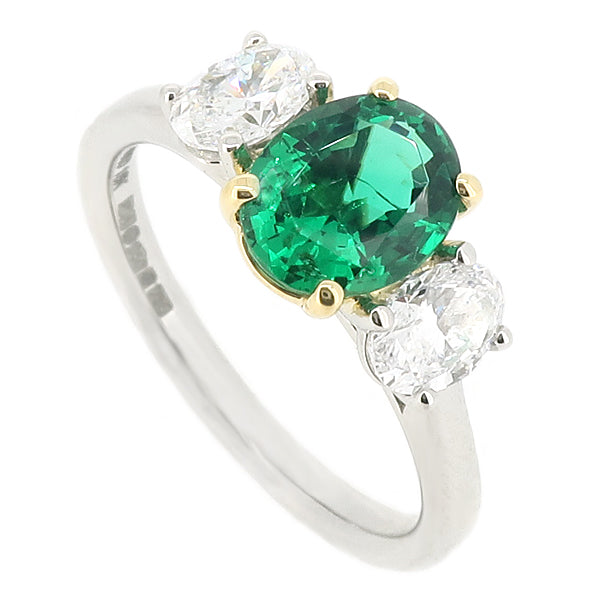Our Emerald Story

Emerald is amongst the most popular gemstones, and one classically regarded as precious. It is the green variety of the mineral beryl, and most famous for its strikingly bright colour. Popular throughout history, emeralds were a favourite gem of the Egyptian Pharaoh Cleopatra, and known amongst the great South American civilisations, before being introduced more widely to Europe after South America was colonised by Europeans in the sixteenth century.
When choosing a piece of emerald jewellery, there are several factors to consider, all of which will have an impact on the price of the item. Selecting the right piece for you can often be a compromise between preferences and budget. So, what characteristics might you need to consider?

Shape.
Since emeralds are most prized for their colour, shapes are typically selected that best show off that feature, although they should also pay heed to the physical properties of the gem too. Emeralds are quite brittle and prone to fracturing if knocked or handled roughly. The most common cut for this gem is a rectangular shape with truncated corners, creating an octagonal outline. The cut is so synonymous with the stone that it is known as the emerald cut (even when seen in other gemstones!) This shape is ideal for showcasing colour and protecting the more delicate corners from damage.

Ovals are also popular, well-suited to emeralds, and offer a more rounded outline if straight lines aren’t your preference. In modern jewellery, a wide variety of shapes are available, although special care should be taken with those that have sharper corners or points!
Colour.
We have mentioned already that colour is the principal factor for consideration when selecting an emerald. Most emeralds receive their colour from traces of chromium within their crystal structure, the element contributing to the gem’s famously vibrant hue. An even, intense green is usually regarded as the most desirable, with stones that are lighter or darker than this ‘optimum’ generally more affordable, all other factors being equal. It should be remembered that attractiveness is a very subjective quality though, and if you prefer a lighter or darker hue, that is absolutely fine!

Clarity.
Part of the reason that emeralds are brittle is that they are very prone to forming with internal fractures and fissures, in addition to a variety of mineral inclusions (small crystals of other minerals) that are also commonly seen. So characteristic of the gem are these, that they are sometimes referred to as the ‘jardin’ or ‘garden’ of the emerald, after their likeness to foliage trapped within the stone. Like most gemstones, emeralds form in the violent geological conditions of the Earth’s crust, often in veins where superheated liquids travel through the rock, the mineral crystallising as the liquids begin to cool. In such conditions, crystals rarely form perfectly, and it is particularly usual for emeralds to grow with extensive inclusions.

Some gemstones are expected to be quite free of inclusions, with none visible to the unaided eye. This is not the case with emeralds, which are rarely seen without very obvious inclusions, and you should keep this in mind when choosing a stone; very valuable emeralds can still contain inclusions that are easily spotted, although those with the most extensive features will still typically be more affordable, all other factors being equal.
This characteristic also generally diminishes the transparency of emeralds, which often have a less lively appearance than many other gems. The colour is the key thing, with emeralds having less to offer in terms of sparkle.

Treatments and Care.
It is also important to be aware that, due to their propensity for fractures, emeralds are routinely treated with oil to improve their appearance. The presence of the oil in fissures that reach the surface of the stone helps to disguise them, making them harder to spot. Unless the stone is supplied with a reputable laboratory report stating otherwise, it is generally safe to assume that the stone has been treated in this way. Sometimes, polymer fillers are used instead, although these should be disclosed more explicitly as they are not assumed.
Filling treatments can deteriorate over time, and may be damaged by cleaning, so care does need to be taken. Ultrasonic and steam cleaning are not suitable for emeralds, and neither are gold cleaning solutions/baths.
It is also a good idea to remove emerald jewellery when undertaking activities during which the stone could get knocked, such as housework or going to the gym, and also for showering or cleaning. Emeralds are not ideal for everyday wear, but with the correct care, are a beautiful gemstone to be treasured and enjoyed.

Location.
Emeralds are found in a variety of countries around the world, and a range of qualities may be found in each locale. The most famous location for emeralds is Colombia, traditionally associated with fine quality stones. Most emeralds in the marketplace today are sourced from Brazil and Zambia, and both locations provide beautiful gems.
As with all gemstones, quality varies, and even locations famous for their quality produce a broad spectrum. It is crucial to remember that location does not guarantee quality, and a beautiful Brazilian stone will be both more attractive and valuable than a poor quality Colombian one. All other factors being equal, however, a Colombian stone will attract a premium.
Since emeralds form with a wide range of mineral inclusions, it can sometimes be possible for laboratories to give a professional opinion on the likely location from which a stone was mined. This is because the types of minerals and geological conditions present in different locations is quite specific, so the presence of a particular inclusion, or a combination of inclusions can be strongly suggestive of a locale.

At PA Jewellery, you will find qualified gemmologists to answer any questions you have about emeralds, and we can show you a variety of qualities, shapes, and sizes of stone to help you find your perfect piece. If you have specific requirements or are looking to produce a bespoke piece, get in touch and we will endeavour to bring your ideas to life!


Comments on this post (0)